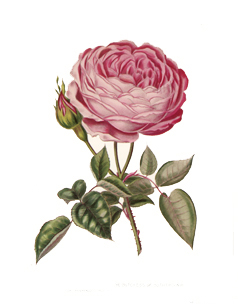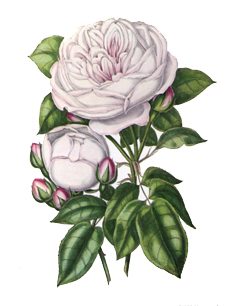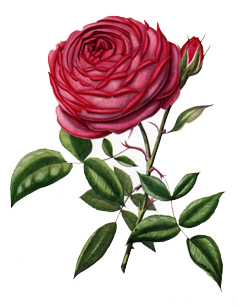The Hybrid Perpetuals
Rosa damascena hybrida
Reverend Joseph H. Pemberton 1908
 We have probably noted that the Hybrid China Roses are the offspring of varieties of the French and Provence roses fertilized with R. indica, an autumnal-flowering species. Although the roses produced by this hybridization were, with one exception, like the seed-bearing parents summer-flowering only, nevertheless the perpetual flowering strain was there. It skipped this generation, but came out in the next it passed, as we might say, from grandfather to grandson, and this great advance in rose culture, the coming of the Hybrid Perpetual, was effected in the following manner.
We have probably noted that the Hybrid China Roses are the offspring of varieties of the French and Provence roses fertilized with R. indica, an autumnal-flowering species. Although the roses produced by this hybridization were, with one exception, like the seed-bearing parents summer-flowering only, nevertheless the perpetual flowering strain was there. It skipped this generation, but came out in the next it passed, as we might say, from grandfather to grandson, and this great advance in rose culture, the coming of the Hybrid Perpetual, was effected in the following manner.
The Damask was the premier rose in the early days of the last century, and fertilizing the Damask with the Hybrid China produced in this, the third generation from R. indica, the Hybrid Perpetual, which thus combines in its constitution the strain of R. indica, French Provence, and Damask, the influence of the last named preponderating. It is, however, difficult to account exactly for the Hybrid Perpetual, because the scientific method under which the seed of the modern roses is obtained was not pursued at that time. Apparently the practice was to gather the seed heps which had been naturally fertilized by wind or insects, and sow the seed in beds in the open; thus they ere chance seedlings from flowers naturally, not artificially, fertilized.
The first so-called Hybrid Perpetual* as we have observed, was that known as the Damask Perpetual, Rose du Roi, or Lee's Perpetual, but since this variety is said to have owed its origin not to a cross with another hybrid, but to a doubtful species, the Rose of Paestum, and is thus, like a Hybrid China, a rose of the first generation, we are not surprised to learn that several of the best varieties, of which the Damask Perpetual was the parent, were only summer flowering. Before a reliable race of Hybrid Perpetual was obtained, the Damask Perpetual had to be crossed with the Bourbon and China, and for this we are indebted to M. Laffay, the originator of the Hybrid Perpetual as we have it now.** Some of the earliest and most noteworthy sent out were Princess Hélène (1837), Duchess of Sutherland (see top illustration) and Madame Laffay (1839), Queen Victoria (1840) (see second illustration and notes at bottom of the page), La Reine (1843) and William Jesse (see lower illustration). By 1840 twenty varieties were catalogued, and although many more were brought out during the next twenty years, nevertheless they were not of such excellence as to entirely supersede the old summer-flowering favourites. The one hundred varieties which, in 1857, won chief prize for cut roses comprised only fifty-four Hybrid Perpetuals, twenty-three others being summer-flowering. The Hybrid Perpetual reigned supreme from 1860 to 1890; there were no Hybrid Teas or large Teas to challenge its position.
 Extensive as this class is, the varieties appear to range themselves in distinct groups or types, differing in wood, foliage, flower, and habit. This is due to their parentage, for they have all come from a comparatively few varieties, the chief of which are as follows:- Extensive as this class is, the varieties appear to range themselves in distinct groups or types, differing in wood, foliage, flower, and habit. This is due to their parentage, for they have all come from a comparatively few varieties, the chief of which are as follows:-
Gloire de Rosaménes (Vibert, 1825), a rose of an earlier generation than the others, and to which it appears we are indebted for Géant des Batailles and many other brilliant roses with red prickles, such as Alfred K. Williams. Probably also Générale Jacqueminot.
Jules Margottin (Margottin, 1853), a prolific parent, from which have been produced such types as Annie Laxton, Marquise de Castellane, Duchesse de Vallombrosa and many others.
Générale Jacqueminot (Roussel, 1853), giving us strong growing reds, as, for instance, Marie Baumann, Senateur Vaisse, Duke of Edinburgh, and most beautiful of all Horace Vernet.
La Reine d'Angleterre, presenting roses of the short, sturdy, erect type, such as Baroness Rothschild, Merveille de Lyon, and Gustave Piganeau.
La Reine (Laffay, 1843), from which came François Michelon, Anna de Diesbach, and others of which these are types.
Charles Lefébvre (Lacharme, 1861), the parent probably of such smooth-wooded varieties of dark reds as Comte Raimbaud, Victor Hugo, Duchess of Bedford, and others.
Victor Verdier (Lacharme, 1859). This is the chief parent of the class. To it we are indebted for those short, stout, upright, free-flowering varieties, such as Marie Finger, Étienne Levet. Comtesse d'Oxford and Suzanne Marie Rodocanachi. Rabbits are fond of this class, especially the last-named variety, preferring it to any Tea or Hybrid Tea; and from this fact we may conclude that a high degree of the Tea element (R. indica) is contained in the Victor Verdier race.
 Some Hybrid Perpetuals that were first favourites with my father - they were all grown on standards - and are numbered amongst my earliest acquaintances in the rose world, were Baronne Prévost, clear bright rose, one of the finest of those days; La Brilliante, a bright transparent red; Duchesse de Caylus, a red of the most perfect form; Caroline de Sansal, very large, flesh colour; Gloire de Santenay, dark crimson; Duchess of Sutherland (top illustration), rosy pink, very double; Madame Laffay, rosy crimson, most highly esteemed, and last but not least, Géant des Batailles, the brightest of all the roses -would there be more like this in the present day. A truss of this was glorious, with its dazzling, almost scarlet, central flower embosomed in fine foliage with clustering buds. We may have improved upon it in form, but not in color. And then the perfume, the true Damask perfume of these old favourites! For this, if for no other reason, one longs for their revival. Some Hybrid Perpetuals that were first favourites with my father - they were all grown on standards - and are numbered amongst my earliest acquaintances in the rose world, were Baronne Prévost, clear bright rose, one of the finest of those days; La Brilliante, a bright transparent red; Duchesse de Caylus, a red of the most perfect form; Caroline de Sansal, very large, flesh colour; Gloire de Santenay, dark crimson; Duchess of Sutherland (top illustration), rosy pink, very double; Madame Laffay, rosy crimson, most highly esteemed, and last but not least, Géant des Batailles, the brightest of all the roses -would there be more like this in the present day. A truss of this was glorious, with its dazzling, almost scarlet, central flower embosomed in fine foliage with clustering buds. We may have improved upon it in form, but not in color. And then the perfume, the true Damask perfume of these old favourites! For this, if for no other reason, one longs for their revival.
It would be of little practical service to enumerate here the best Hybrid Perpetuals, the list is ever changing, and the appendix will, one trusts, supply the requisite information. Since 1890 this race has remained almost stationary, the Hybrid Teas being now the progressive party. But before we pass to a few words on cultivation, permit it to be once more emphasized that we expect and must have perfume in a rose - the perfume derived from the strain of Damask and Hybrid Perpetual; and let us hope that our eminent raisers of new varieties will give this point some little consideration. Lovers of the Queen of Flowers look for that virtue in her that makes her the queen, and without which she is but a camellia or a cactus dahlia.
Beautiful of the roses of this class are, yet, taken as a whole, Hybrid Perpetuals are not good autumnal flowers; they are surpassed by the Teas, Hybrid Teas, and Chinas. Nevertheless, in brilliancy of colour nothing can equal them; poor indeed would be the rose garden that did not contain such sorts as Charles Lefébvre, Comte Raimbaud, Horace Vernet, Marie Baumann, Ulrich Brünner, and Victor Hugo; we cannot afford to lose these roses.
When we come to consider the question of pruning and general culture of the Hybrid Perpetual we are at a loss to know exactly what to say. Each variety has its idiosyncrasy; its own virtue and fault, its own habit and growth, the knowledge of which can be obtained only by close acquaintanceship. For instance, no rule as to pruning could be laid down, even for garden purposes, which would be equally applicable, let us say, to Ulrich Brünner and Victor Hugo, nor, if required for exhibition, would be the same advice on disbudding suit both Générale Jacqueminot and Her Majesty. All we can state here is that the Hybrid Perpetual is hardy, and in a normal winter requires no protection. Like most roses it does best in open situations, or apart from other flowers. It should be left unpruned, but the weaker the variety the harder - the shorter- should it be cut, and vice versa.
*"Hybrid Perpetual" is used a literal translation in this context: A rose which has been hybridized and which is perpetual, or repeat-flowering.
**Laffay introduced Princesse Hélène in 1837, which the author understands to be the first Hybrid Perpetual.
Top illustraion of Duchess of Sutherland from Beauties of the Rose by Henry Curtis 1850-53
Center illustration of Queen Victoria from Beauties of the Rose by Henry Curtis 1850-53 (Jean Laffay hybridized a rose with the same name in 1839. William Paul described that rose as bright rosy purple, medium size, very double. The Queen Victoria illustrated was bred in 1851 by an unknown breeder. Henry Curtis noted this rose resembled and seemed to be raised from La Reine (Laffay, 1842). Brent Dickerson gives the synonym La Reine à Fleurs Blanches in Old Roses: The Master List). Both of these Queen Victoria roses were sold at the same time under the same name. Both roses now appear to be lost from cultivation.
Lower illustraion of William Jesse from Beauties of the Rose by Henry Curtis 1850-53
Text from Roses, Their History, Development and Cultivation by Reverend Joseph H. Pemberton, 1908
©2005 Daphne Filiberti
www.RoseGathering.com
|













